Proving your value in sales can be challenging, but with key HubSpot reports any salesperson can easily show their worth and sales managers can easily manage and grow their teams.
It’s easy to show your value when you have hard numbers to back you up, and that’s where
HubSpot and it’s CRM proves itself invaluable for any sales team.
By taking a data-driven approach, sales reps can benchmark their performance and showcase not only their efforts, but also their results, and sales managers can start to take note of where their teams can improve and use data to help them grow and sell more.
Take a look at these key reports to see how you can use HubSpot to close more sales and keep your sales teams aligned with both marketing and service.
1. Deals closed versus goal
Great salespeople are driven by results, so this chart can quickly show them, and their managers, the revenue from closed deals compared to quota across whichever time range they choose.
Steady growth and consistent effort play a big part in resultant success. Deals get delayed and lost, so this graph aids the course correction early.
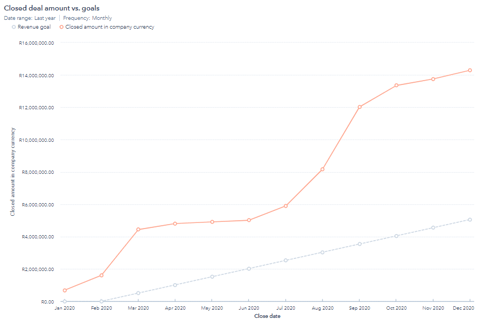
All data included is from imported test data for demo purposes
2. Deal leaderboard - amount closed by rep
This report, more than any other, promotes competition between individual team members. Gamification fuels healthy rivalry and this comes through transparent contribution reporting.
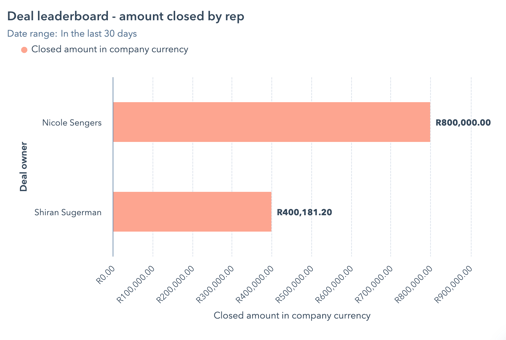
All data included is from imported test data for demo purposes
3. Deal Forecast
As long as the deal has the correct deal value, is in the correct deal stage, and the projected close date is accurate, then sales managers and other business leaders can view the forecasted revenue in any timeframe they choose. This combined company amount can then also be further filtered by team as well as by individual sales rep.
If sales reps and sales managers can’t monitor how closely they are trending to their goals, then they cannot prepare and adjust their plans accordingly.

All data included is from imported test data for demo purposes
4. Deal totals by stage
As important as it is to strive for an even revenue distribution across your pipeline/s, so too is the total number of deals in each stage of any pipeline.
The expression “Don’t put all your eggs in one basket” rings true - especially if you have one or two whales in the forecast. Sales reps sometimes suffer with too little coverage because they don’t manage their exposure by spreading their risk across enough deals. On the flip side, and depending on the complexity of the sale; if a sales rep is juggling too many qualified opportunities, there may be a risk that one or two won’t get the attention they need and will end up dropping off.

All data included is from imported test data for demo purposes
5. Activity leaderboard by sales rep
Just like any skill, selling successfully takes practice. Not in all cases, but definitely in most - there is a direct correlation between the volume of calls made, emails sent, and meetings held and the volume of sales ultimately generated.
Sales reps aren’t robots. This report serves as an early warning sign because it is critical that their tasks, calls, notes, emails, and meetings logged are consistent from month to month and that leads and opportunities are getting the attention they deserve. However, no matter what the data throws up, sales capacity and allocation of effort should always be further analysed for better resource allocation decisions.
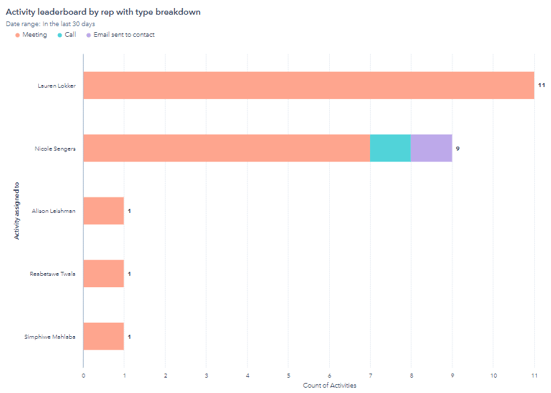
All data included is from imported test data for demo purposes
6. Open deals set to close this month
Depending on the average deal cycle length, sales reps and their managers should do a formal review of their pipelines every week, or bi-weekly. This report is really useful to prioritise and develop an action plan of next steps to deal closure.
As much as we’d like to think that sales reps keep the statuses of their deals accurate, most often they don't. They are also prone to over-optimising or worse - “sandbagging.” So when they're asked to quickly summarise each deal, it's often evident that the deal stage, expected close date or deal value needs to be adjusted.

All data included is from imported test data for demo purposes
7. Closed revenue amount by lead source
Knowing which channels are the best sources for good quality leads that convert, helps sales and marketing teams to prioritise and shift their resources effectively.

All data included is from imported test data for demo purposes
8. Length of the sales cycle/Deal velocity
This report contains information on the number of days it takes a sales rep to close a deal and is important at a company level, a team level, and an individual level. Sales reps with a shorter sales cycle than the company average are doing a great job. Sales managers can use their success learnings to assist the other team members who are struggling to keep up. It is also important for forecasting certainty and resource capacity.
If your sales cycle length doesn’t progressively decrease as your organisation strives to remove friction from the flywheel and streamline the buyer journey, or worse if it actually increases, then there the warning bells should be ringing and you may need to drill down on your process, people and technology you employ to identify where the bottlenecks are.
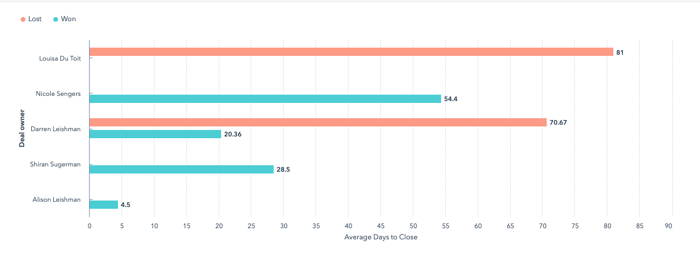
All data included is from imported test data for demo purposes
9. Lifecycle Stage Funnel Report
This report allows you to have a visual representation of your contact’s lifecycle stages. This tells you exactly which lifecycle stage every lead in your pipeline is in as an individual. If you do not track your lifecycle stages, reporting becomes almost impossible. Additionally, it will give you insights as to what actions you should take regarding your leads.
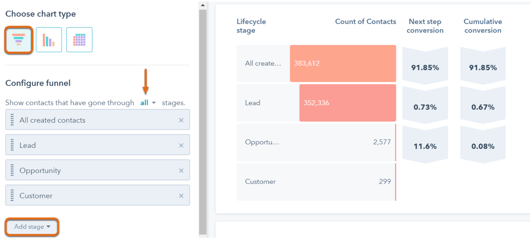
All data included is from imported test data for demo purposes
10. Counts of Contacts (by Industry and other relevant filters)
This report helps you identify who your contacts are and allows you to filter them by relevant industry, product or any other contact property. This will help you identify opportunities to connect with your contacts.
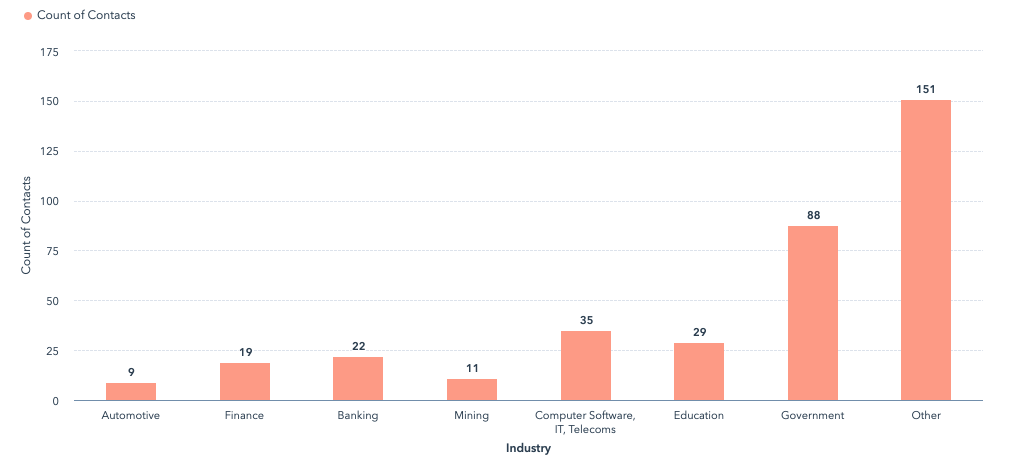
All data included is from imported test data for demo purposes
11. Overall Sales Performance/Activity
As a sales rep or manager, this report gives you a quick view of your overall sales performance. This helps you know whether or not you need to be ramping up your sales efforts.
You could be underperforming and not be aware. Ideally, all the arrows should be green.
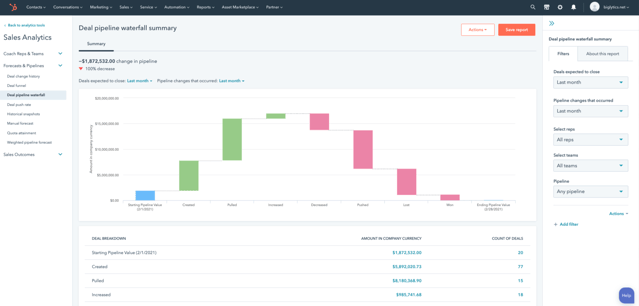
All data included is from imported test data for demo purposes
12. Companies Reports
This allows you to track your companies in terms of how long it takes for them to make purchases and this is important because you can know which companies are likely to buy during your prospecting efforts. Dangers of not doing this include wasting time on companies that never buy or buy very scarcely. In the below example, we filtered by the original source to further drill down on the data.
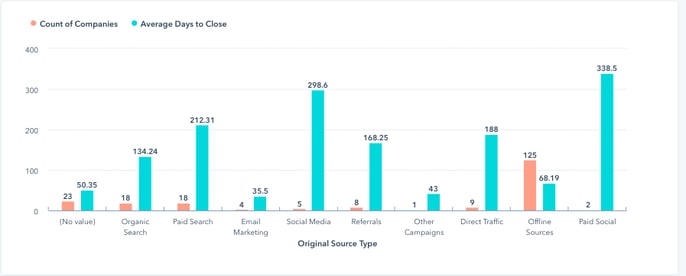
All data included is from imported test data for demo purposes
Another great element to HubSpot reports is that each of these can be clicked on to drill down into the data that makes up the charts. So you can go into any element you like and easily access the deal, contact, company data.
As you can see, there are so many useful reports you can pull through HubSpot to not only help your sales team grow, but also to drive insight and business growth.
If you’re interested in starting to use a variety of reports like these to both understand and showcase your performance better, sign up for HubSpot’s Free CRM.
